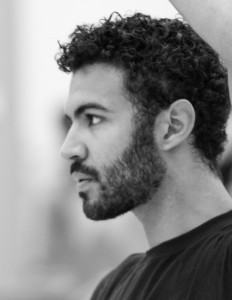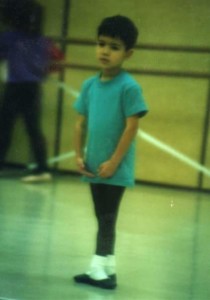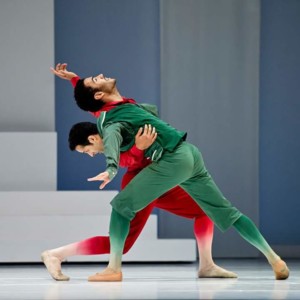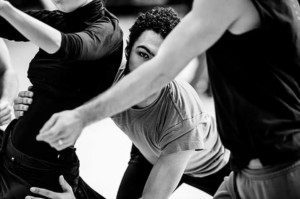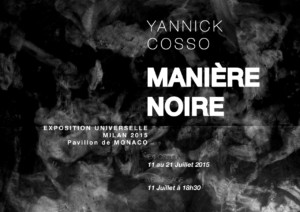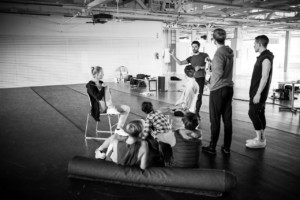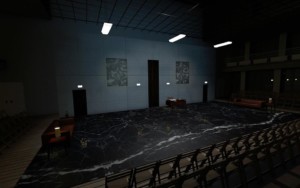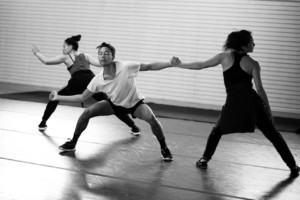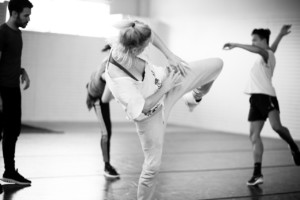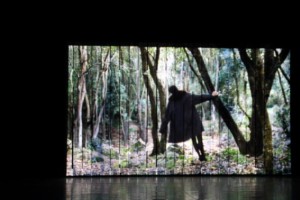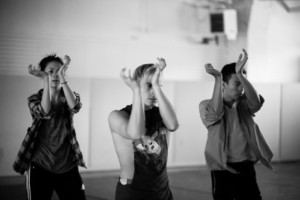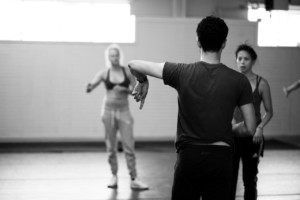“I’m not sure I remember a time when I wasn’t going to be a dancer or in the theater or music,” says Joseph Hernandez, one of the 3 choreographers of Whim W’Him’s upcoming Second Choreographic Shindig program at Erickson Theater on Capitol Hill Sept 9-17, 2016. Joseph grew up in Germany mostly, in a small town called Ketsch near Heidelberg, in a “very musical family.” His father, who also rode a motorcyle, played clarinet in the U.S. Army band, while his mother was trained as an opera singer, though she now teaches. Both his parents were adamant that the family live off base, which meant “friends, travel, lots of learning about how to assimilate.” In school on the base, math and science were in German, history and English in English.
As to the arts, just before the family went to Europe, “I started ballet at 4, and it stuck.” That was with the Youth Services dance program Joint Base Lewis-McChord in Tacoma, WA. Over in Germany, he trained with Carolyn Carattini and Isabel Christie,at a small studio in Heidelberg. When Joseph was in high school, the family returned to the US, this time to Killeen, Texas, where he took classes briefly from the Ballet Austin Academy. But, as he says of the move, “I couldn’t take Texas, and went off,” on his own, to New York City. “I wouldn’t necessarily recommend it for a teenager,” he admits, “but it was great for me.” He auditioned successfully for the School of American Ballet. “It was,” he notes, “an informative experience. Not super-traditional. Balanchine departed from the classical tradition.” And Joseph was interested in observing and trying out the ways that divergence could happen. After completing his dance training at SAB, doing academics at a local public high school, and hoping to be invited to join the New York City Ballet, Joseph was in fact offered a contract.
At the end of two years with NYCB, however, “I sustained an ankle injury that made me reevaluate why I was dancing.” He explains, “I wanted to learn and to be challenged in ways that I wasn’t being offered in the states. Also culturally, since growing up in Germany, Europe felt more like home. I wanted to learn a bunch of languages and see many different ways of thinking about life. I feel proud because I feel I’ve basically accomplished this.”
Joseph choreographed his first piece, We, Tender, in Antwerp, for the Royal Ballet of Flanders’s “Coupe Maison” series in 2012. He went on to dance with Les Ballets de Monte Carlo and to participate in a program for beginning choreographers and set designers, where “they pair you with designers,” to do work in “a mentoring situation.”
That was where he met installation artists Yannick Cosso and Jordan Pallages and, in 2012, formed the Nielsson Collective (named after a “fictive” character, J. Nielsson). He has worked very closely with them since, focusing “on the research of narrative and collaboration, and the place these concepts have in contemporary art.” He says “I like working with them. They keep me honest. They stop me and ask me to explain and teach me a lot, so I never get self-satisfied.” When I asked if they were involved in the Shindig process at all, he said, “Yannick and Jordan are involved, however remotely. They counsel me from time to time and they help me problem solve. They are really close friends and in my opinion it’s always good to feel that you work in a team, no matter who is doing the heavy lifting.”
While in Monaco, he made two pieces for Les Ballets De Monte Carlo, Sawdust and Rust (2013), and Persistent Sequence (2014). Subsequently, until this Whim W’Him commission, Joseph has pretty much been dancing full time at the the Semperoper in Dresden, opera house of the Sächsische Staatsoper Dresden, concert hall of the Staatskapelle Dresden, and home to the Semperoper Ballett.
“Being employed as a classical dancer in a large opera house has taught me so much about what it means to be a choreographer,” says Joseph, “and what it means to create validity though dance. Because of the range of work that we tackle at the Semperoper, and the other theaters I’ve worked for, there is an active library of knowledge to pull from when evaluating my own stance on the future of our art form. I like to think of it as research. Choreography is about organization of thoughts and people. In an ever changing environment, these ideas and people are mercurial, and I believe our work should reflect this. “
The connection between Joseph and Whim W’Him began when he heard about the company from old SAB friends and dancers at Les Ballet de Monte Carlo. He applied for Shindig late, as it turned out, because of a confusion over time zones. But even before the piece now being created is premiered, the connection has already proved fruitful. “It sparked a series of other things,” including a full length, entitled Orakel, to premiere at the Semperoper this November and a residency at S T O R E Contemporary, an arts space in Dresden, along with Yannick and Jordan. “A lucky situation,” he remarks.
Getting the Whim W’Him commission, Joseph says, “after doing dancing mostly for some time, made me feel like a choreographer again.” (The last thing he’d done was the second piece for Les Ballet Monte Carlo a couple of years ago.)
For Shindig, he intended to do something very specifically on the people here. He wanted to make “a challenging and complicated piece—dancers like feeling they’re accomplishing something.”It would involve “academic study and concentration, improvising and story-telling. And enjoying it.”
Going into the studio for the initial rehearsal, he says, “I was super-nervous. I threw a lot of information at the dancers, to see how they would react.” They spent the first couple of days, getting to know each other. His idea was to “keep on task, deviate as necessary, and have fun.” He also liked the idea of rehearsing at Velocity where there are “no mirrors and big floors.”
There’s a certain tongue in cheek quality to Joseph’s attitude to this material, he allows. “How do we interact with impending doom. What’s important?” His piece for Shindig is named SARO after an Appalachian folk song with roots in pre-18th century England (and sung by Bob Dylan in the 1970s). Ideas about it come from “two worlds”—very different ones—that continue to draw and inspire Joseph: an office or library with file cabinets or shelves…
…and a “creepy, woodsy” place where strange things happen.
(His new Dresden creation takes place in the office of an oracle.) He’s thinking of X-Files (the nineties TV show) and also about the early 20th century horror story writer H.P. Lovecraft, a lot of whose work he’s been reading. He is very much intrigued by the internet’s current fascination with Lovecraft, who died penniless and unrecognized in 1937 at the age of 46.
Joseph has always enjoyed words. Often there is speaking in his pieces. For SARO, he has commissioned a score from Caroline and Thomas Beach, a brother-sister team with whom he has worked before. “They created a 25 minute score and performed it themselves.” It has elements of contemporary and ancient music. “It’s very dynamic, and there something nice about working on something commissioned for a certain piece.” Joseph likes working with music specific to the project at hand. “With already written, especially famous, music, it’s not that you are stealing or twisting it to what you want exactly, but appropriating it.”
Says Joseph of the score and how it’s being used, “The Pretty Saro song is of the old Appalachian base with a few lyric and melodic twists. We are using it less as a description of the narrative and more as a mantra. All of the concepts, the Lovecraft inspiration, the Appalachian folk music, are used as a springboard to develop that universe with three dancers. I like to work with as many images as possible, and then let the imagination of the dancers run wild.”
Photo credits: Headshot by Ian Whalen; Joseph dancing by Alice Blangero; Manière Noire poster by Yannick Cosso; double photo, works by Jordan Pallages at Pavillon Bosio, Ecole supérieure d’arts plastique de la ville de Monaco; Whim W’Him rehearsals by Bamberg Fine Art Photography
